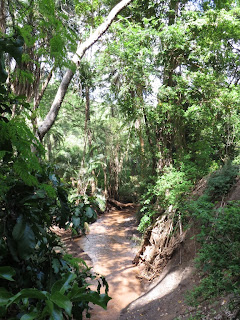Today was our second homestay of the semester. This time around, our homestay families were Maasai (most of the people in the Kimana, Kenya area are Maasai), and we got to get our a hands a little dirtier than our previous Iraqw homestay in Kenya. Danielle and I were partnered together this time around, and almost immediately after being dropped off at our Mama's house, we were put to work.
Maasai homestay Mama and I- modeling some beautiful Maasai jewelry that she handmade.
First, we walked about a mile to the nearest water source, a small stream, and filled three canteens with water. Now, the walk there was a breeze (the canteens were obviously empty), but the walk back was a comedy show. Maasai women have some tough skin (and heads), and they are able to carry unbelievably heavy and/or bulky things. I found out fast that I would not survive the Maasai Mama life for long. As soon as my Mama handed my the water canteen and motioned for me to put the strap on my head, I knew I was in trouble. I managed to get about 500 feet from the stream before my strap on the water canteen broke and got only about 500 more feet beyond that before I gave up head carrying altogether. Instead, I somehow decided positioning the strap precariously close to my throat was the better way to go (it definitely wasn't). Miraculously, I made it back to the boma. Danielle fared much better than me and managed to carry her water canteen strapped to her head the entire way. The Maasai is strong with that one.
After collected water, we had tea time and began cooking food for chakula cha mchana (lunch). First, we cooked ugali (basically is flour and water boiled into a large mass of food). And when I say we, I mean our Mama laughed at us while "attempted" to stir the hot, sticky, pasty mess that is ugali in a pot. After finishing the ugali, we moved onto cutting cabbage and tomatoes. Our Mama told me I was excellent at cutting cabbage and that I must have learned well in Tanzania. The tomatoes on the other hand, she laughed at me just as she did with the ugali.
The pro cabbage cutter (in case you can't gather it from the picture, I'm referring to myself)
Maasai Mama rocking the cabbage cutting
After lunch, we had some down time to play with the kids. I obviously spent most of my time admiring the 6 month old and conspiring a plan for stealing the gorgeous child away (of course I would never do that, but her chunky baby arms were so damn cute I couldn't resist the thought). After playing, Danielle and I were taught how to make Maasai bracelets. I've bought so many during the course of this trip and it was really cool to see how they are made. It was also extremely fulfilling to know our work on the bracelets we had made could help our Mama make some more money (I'm sure her handiwork is about 100 times better than ours, but it still felt good to help).
Too much cuteness for one picture.
I seriously wanted to take this child home with me.
My Maasai Mama offered this adorable boy up to me (She was definitely joking). I told her I would take him in a heartbeat (I was definitely not joking).
After playing and beading, we started collected poop. After our experience with out wildlife ecology professor's poop field exercise in Tanzania, we were well prepared for the work, and even though I managed to get thorned about five times, I still found digging in the poop to be thoroughly enjoyable. The collected poop was used to cover wood for the creation of charcoal. Maasai households rely very heavily on charcoal as a source of heat (and therefore cooking), and so this process plays a very huge role in daily Maasai life.
Then torrential downpour happened. We hid up in the Mama's home to wait for the worst of the rain to pass, and then we immediately volunteered ourselves for another project-house building. It was still raining, and we got soaked, but we felt extremely accomplished having helped put together a wall (collected sticks and placing them in-between the structural beams) of a new Maasai home.
When our ride came to take us home, neither Danielle nor myself wanted to leave. I can honestly say that I don't think I've had so much fun with a foreign family or culture in my entire life. Danielle and I speak only very little kiswahili, and our Maasai Mama spoke only a few words of english. I had so much fun learning new words from the kids and teaching them english words as well. Communication was definitely not as hard as I had expected it to be (my sign language is getting unbelievably amazing), and I wish I could have stayed longer to learn more. I loved being able to help our Mama and not be in the way, and playing with the children was such a great rest from the other hardwork we had been doing. I can only hope that people can experience a day like this sometime in their life; it really is one of my favorite experiences of this study abroad program so far.

Danielle and I, homestay family picture take 1 (really probably take 5- the others are so ridiculous I decided to save your eyeballs)
The family! Absolutely adored them.














































